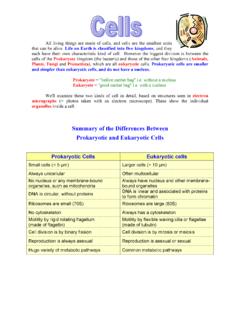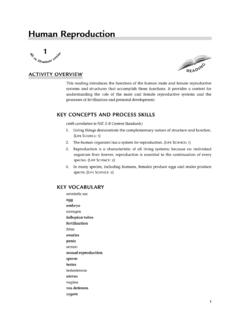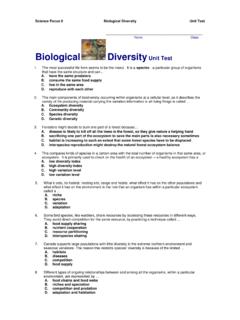Transcription of Cell Continuity - Cell Cycle - BiologyMad
1 Cell Continuity -is the unbroken succession of cells since life evolved billion years ago. New cells can only be produced by cell division. New cells are needed for o reproduction , o formation of multicellular organisms, and o cell replacement. Cell Cycle There are three stages of the cell Cycle : 1. Interphase -The cell grows, proteins are made, the number of organelles increases, DNA replication. 2. Division of the Nucleus: Mitosis: two daughter nuclei, genetically identical the original nucleus, are fis: formaormed. Meiostion of four haploid genetically 3. Cytokinesis vides between the new daughter nuclei. lasm Mitosill nuclei can undergo mitosis. aploid (n): one set of chromosomes is present in the nuclei ( only one of each different Roo r organism. eproduction Amoeba, yeast and vegetative reproduction of plant. lls. umber of somatic (= normal body) cells . different daughter nuclei from the original diploid nucleus. : The cytoplasm di Therefore each nucleus with its allocation of cytopbecomes a new cell.)
2 S A Hchromosome is present.) Diploid (2n): two sets of chromosomes are present in the nuclei ( two of each different chromosome are present.)le f Mitosis Formation of a multicellula Asexual r Cell replacement and regeneration. Faithful copying of genes and their transfer to the next generation of nuclei or ce Maintains the correct chromosome nStages of Mitosis (Interphase); Metaphase, Anaphase, Telophase. (Interphase) (Mnemonic I Pee MAT) Prophase chromatin condenses forming chromosomes chromosomes shorten, thicken, coil, dehydrate each chromosome consists of two identical sister chromatids o connected at the centromere centriole divides forming the spindle fibres nuclear envelope breaks down at the end of prophase Metaphase chromosomes placed individually along the equator of the cell each chromosome is connected by two sets of spindle fibres attached to the centromeres Anaphase separation of sister chromatids, now termed chromosomes the centromeres spit when the spindle fibres shorten shortening results in two identical sets of chromosomes at opposite sides of the cell Telophase each chromosome group becomes a nucleus when a nuclear envelope is formed around it the chromosomes uncoil to chromatin o chromosomes lengthen, uncoil, rehydrate Definitions Chromatin.
3 DNA in its normal , functional state condenses to form chromosomes. Chromosomes: condensed chromatin showing up as a group of short thread-like structures only visible with the light microscope in nuclei during mitosis and meiosis each chromosome carries a specific set of genes in linear order at particular loci (= sites) Chromatid: often described as half a chromosome it is one of two threads of condensed chromatin forming one chromosome the two threads are connected together at the centromere after DNA replication (S phase) they exist only during prophase and metaphase ( when chromosomes are X-shaped) Centromere: a non-DNA region of a chromosome where sister chromatids are held together and spindle fibres attach. Meiosis Meiosis: the division of a diploid nucleus to form four haploid genetically different daughter nuclei. Role of Meiosis Increases genetic variation in the population role in evolution Makes sexual reproduction possible Gamete formation in animals, fungi, protoctista Man Site of Meiosis Animals testis - forming sperm, the haploid male gametes; ovary - forming egg cells , the haploid female gametes.
4 Flowering plants: anther of the stamen - forming the haploid male spores (microspores), ovule of ovary - forming the haploid female spores (megaspores). IHW March 2005












